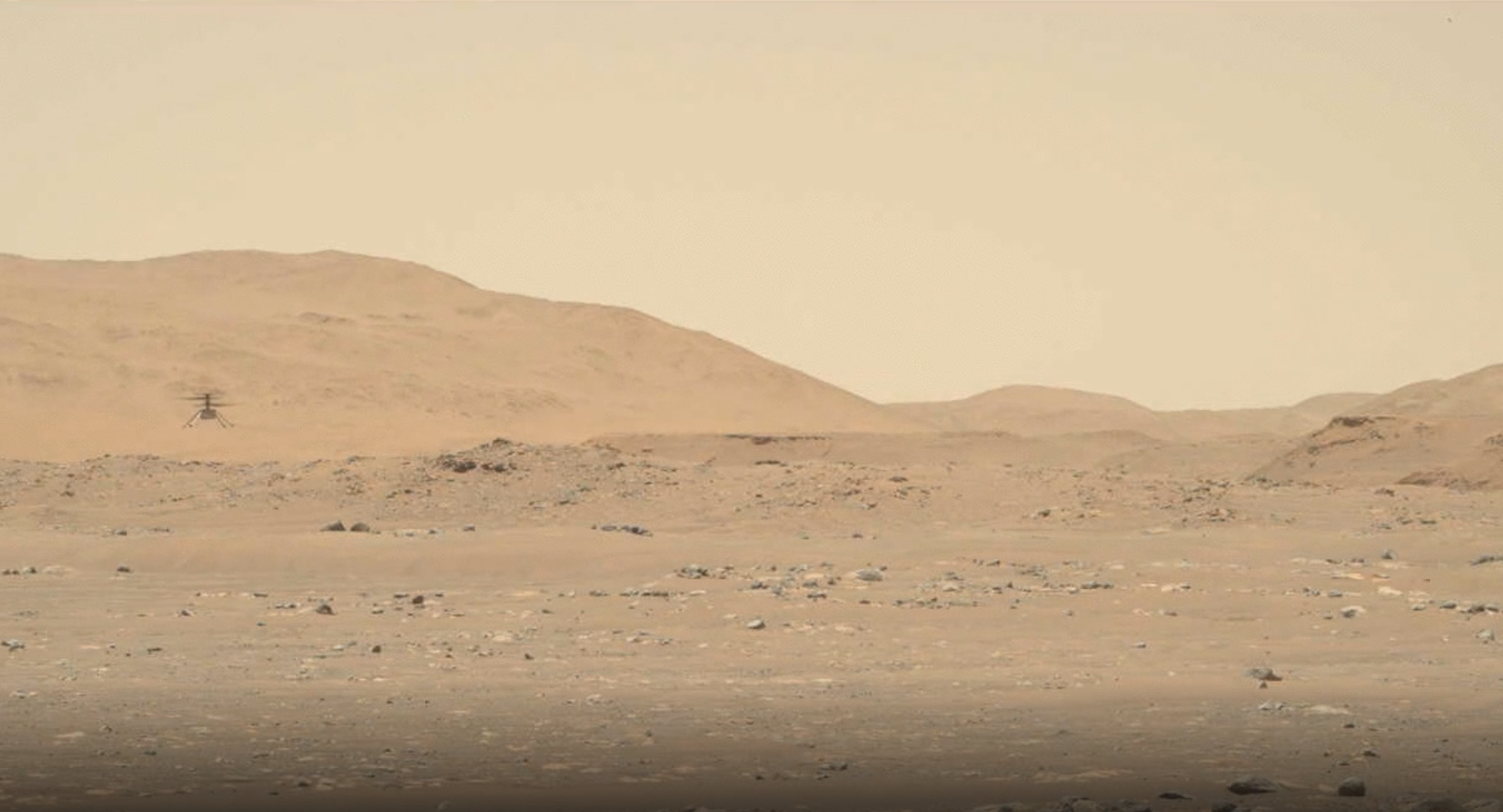Up and Away Into the Wild Butterscotch Yonder

Space art of the Martian surface from the 1950s and 1960s often depicted the planet with a beautiful blue Earth-like sky. But when the first landers touched down they returned color images of a salmon pink sky. Several rovers later and careful white balancing, it seems like the sky on mars is more of a yellowish-brown or “butterscotch” color due to dust in the atmosphere. The atmosphere is very dusty so time of day (sun angle) makes a big difference in sky color. For the most part the dust is good at absorbing blue light, so the sky isn’t blue except around sunrise and sunset.
This month NASA made history with the flight of a heavier than air aircraft on another world. Ingenuity is the name of a small prop-driven drone that flies like an unmanned helicopter through the thin Martian atmosphere. Mars’ “sea level” atmosphere is only 1% of Earth’s and consists mostly (95%) of carbon dioxide, so the blades had to be extra large.
The videos of the drone’s test flights made by NASA’s Perseverance Mars rover have been incredible. Audio of its buzzing whir in Mars’ thin atmosphere was also captured. Because of the thin atmosphere on Mars the two counterrotating propellers with two blades each must spin very rapidly – about 40 revolutions per second – without flexing, wobbling or disintegrating.
As a NASA “test article,” Ingenuity is made up mostly of commercial off-the-shelf (COTS) components. Its motors are brushless and its batteries are rechargeable lithium-ion batteries, just like the mini quadcopter I enjoy flying around inside of the house. Ingenuity uses cell phone processor technology including a quad-core central processing unit (CPU) employing the Linux operating system.
Ingenuity also has special parts not found in most commercial drones, such as a Garmin-brand laser altimeter. Cameras are used to relay images but are also fed into the guidance system that is programmed to follow known terrain features.
Perseverance deposited Ingenuity in a 33’x33’ area designated as the “helipad” and then backed up about a football field to watch. All flights of Ingenuity start and end from this location.
My home mini-quad copter is a toy used mainly for entertaining pets and is controlled in real time (i.e. live) using buttons and levers on a remote control. However, Mars is at such a great distance away that it is directly affected by the limitation of the speed of light. The light travel time to Mars prevents any kind of operator from controlling Ingenuity in real time.
Mars and Earth are closest when the planets are both on the same side of the sun, at opposition. At that distance the one-way light travel time – the time it takes light, radio signals and other information – a little over three minutes to reach one from the other. When at their furthest separation, on opposite sides of the sun at conjunction, the light travel time can be more than 22 minutes. (At the time of this writing, the light travel time to Mars is approaching 17 minutes.)
Therefore, the round-trip time for data to arrive from Mars and, in reaction, a control signal from Earth to reach it takes from around seven to some 45 minutes to complete! Obviously, flight operations for Ingenuity have to be totally autonomous.
To accomplish this, live camera images are used by the onboard processor for identifying terrain features as part of its flight plan. During the flight, data and images are transmitted to the nearby Perseverance which, in turn, uploads it to orbiting satellites which relays the information to earth. The reverse path is used for sending commands from Earth. All of Ingenuity’s sophisticated electronics are contained in a box about the size and shape of a tissue box.
The dream of flying above Mars has been around. In his 2003 futuristic science fiction work Blue Mars (the last in his trilogy), author Kim Stanley Robinson wrote about Martian settlers traveling around Mars in a jet-powered blimp. With Ingenuity’s successful flights, the future of Martian aviation has finally got off the ground.
Unfortunately, the planetarium at BBNC remains closed. The Westminster Astronomical Society (WASI) has been hosting free monthly “virtual planetarium” programs using ZOOM conferencing. The planetarium programs are presented on the 3rd Wednesday of the month starting at 7:30 p.m. ET. The ZOOM address URL can be found on the WASI web site, westminsterastro.org. The ZOOM meeting URL is the same each month for the recurring programs. The next scheduled planetarium program will be on May 19.
–Curt Roelle
